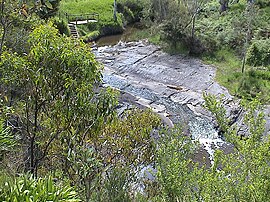Inman Valley, South Australia
|
Inman Valley South Australia |
|
|---|---|

Glaciated pavement in the Inman River
|
|
| Population | 427 (2006 census) |
| Postcode(s) | 5211 |
| Location | 86 km (53 mi) South of Adelaide city centre |
| LGA(s) |
City of Victor Harbor District Council of Yankalilla |
Inman Valley is a valley, locality, and township on the Fleurieu Peninsula, around 86 km south of the centre of Adelaide. The valley is about 380 square kilometres in area. At the 2011 census, Inman Valley had a population of 732.
Inman Valley, and Inman River, was named through association with Inspector Henry Inman, founder and first commander of the South Australia Police, who pursued two allegedly escaped convicts there in August 1838. No Indigenous name is recorded for the valley itself, but two names are recorded for the river: Moo-oola and Moogoora. The mouth was called Mugurank, meaning 'place of hammerstones'.
The first recorded Europeans to sight the valley were likely the party that accompanied explorer Collet Barker (but not Barker himself) in 1831. In its pristine state the valley abounded in kangaroos, which were hunted for food by early sealers and whalers at Encounter Bay.
Inman Valley was surveyed in late 1839 by a party under Senior Surveyor N. Lipscomb Kentish, formerly of Sydney, assisted by Surveyor Henry Ide, formerly a corporal in the Royal Sappers & Miners (see Royal Engineers). They pegged out the sections and also a line of road suitable for drays leading from Rapid Bay to Encounter Bay, which is now Inman Valley Road.
Immediately following the completion of surveys the land was opened for selection and in early 1840 the first European settlers to establish a homestead at Inman Valley were the three young James brothers, William Rhodes James, John Vidal James, and Richard Boucher James. They carved a shortcut – James Track – to their land. In 1858, together with partners, Richard Boucher James purchased the 60,000 acre Canowie Station, where he lived until 1863, when he returned to England. In Devon he purchased the Georgian-style mansion Hallsannery House in the parish of Littleham, from where he continued his interest and management of the Canowie Pastoral Company until his death in 1908.
...
Wikipedia
